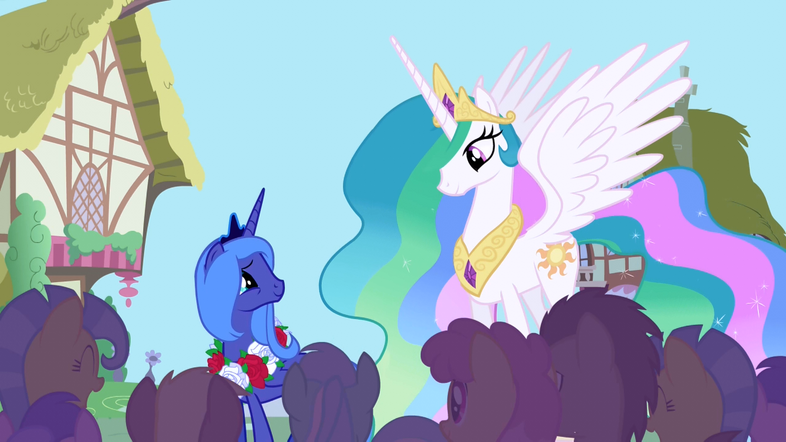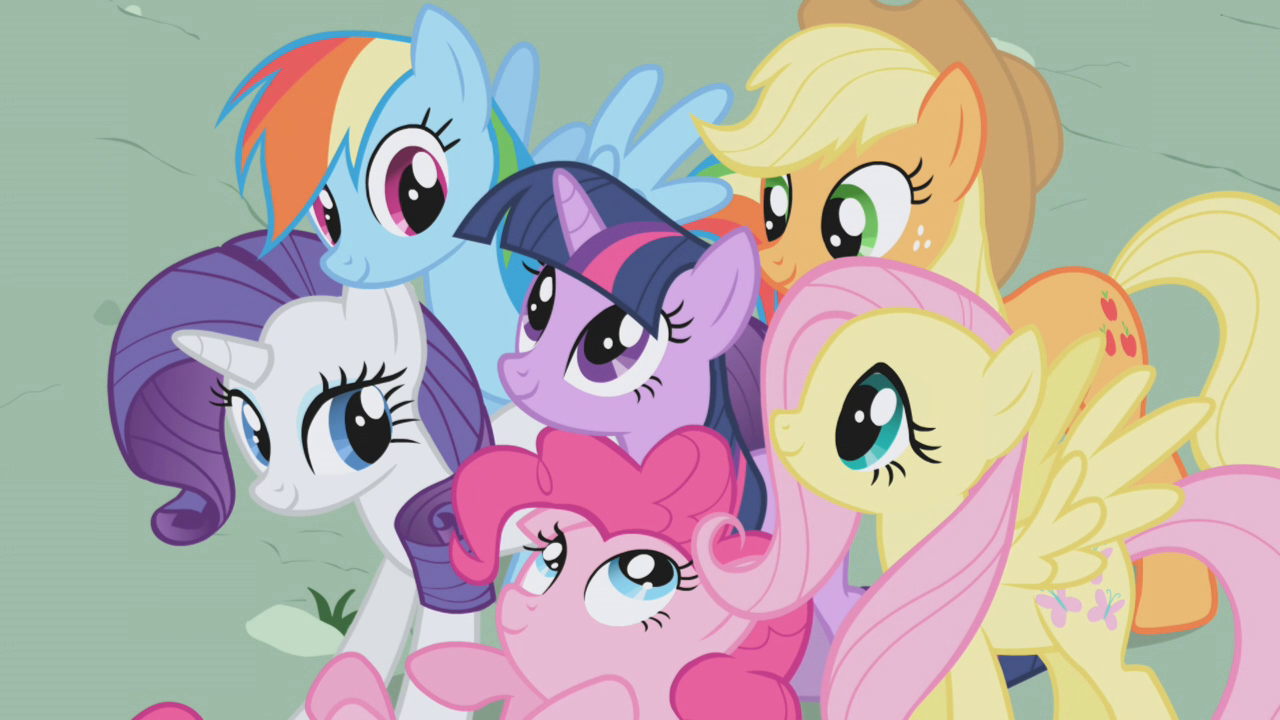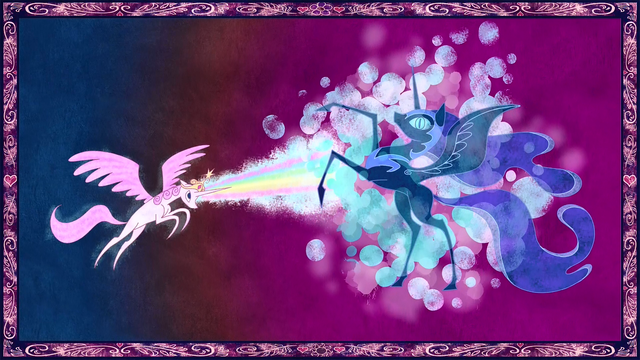[Fr. Z points out that today is the Summer Solstice, the first day of summer. I guess it makes sense to make this the time to post the second part of my review of My Little Pony: Friendship is Magic, considering the ponies themselves mark the occasion in the episode with a "Summer Sun Celebration." The first part of my review is here.]
Friendship is
Magic: Part 2 (Character and Plot Overview)
Now, I neglected to mention the prologue to the first episode of MLP: FiM in the previous
post so I’ll remedy that oversight right now.
The first episode begins with a narrator telling us the back-story to
the Friendship is Magic series. Apparently, two alicorn (unicorns with
wings) sisters ruled over the ponyland of Equestria with tremendous power. The
older sister, Celestia, moved the sun, while the younger sister, Luna, moved
the moon. Peace prevailed throughout the land until the younger sister started
to feel a little sad. It seems that most of the admiration of the pony subjects
went to Celestia, in fact, the common ponies seemed to shun Luna, staying awake
only during the day and going to sleep at night. Right off the bat we see the
moon princesses’ main motivation, which Nate Winchester identifies as “a lack
of appreciation.” Luna thinks she got the raw end of the regency deal and
decides to make things right…by shrouding the land in never-ending darkness and
moonlight so now everypony can admire her at all times. Celestia stops Luna’s
rebellion and banishes her to the moon using the Elements of Harmony.
A thousand years later Luna (or “Nightmare Moon,” both names
are interchangeable) returns to Equestria and once again plans to bring about
“nighttime eternal.” Since Celestia disappears for most the second episode (DGD speculates
she was banished to the sun), it is up to the “Mane 6” to Save the World ™ this
time. What’s that, you say? How can Twilight suddenly become friends with other
ponies despite showing no interest in friendmaking the previous episode? Well,
the first two Friendship is Magic
episodes do serve as a pilot for the series, so they carry the burden of
establishing the world, characters, and relationships. So we find the Mane Five
breaking into Twilight’s home, kidnapping her, and forcing her to become their
friend at hoofpoint…no, I mean Twilight finds out the secret of the Elements of
Harmony can be found in some ancient castle in the Everfree forest and departs,
the rest of the gang sort of tagging along.
 |
| Twilight Sparkle accepting 5 new friend requests on Facebook |
Before she left, Twilight mentioned six Elements of Harmony,
Kindness, Laughter, Generosity, Honesty and Loyalty, with the final element unknown.
Thus, the journey to the ancient pony castle allows a chance for each of the
mane six to display a particular virtue. Applejack, the country pony, is the
element of honesty, as she tells Twilight the “honest truth” about letting go
of a cliff and being safe. Next, Fluttershy, the bashful one, displays the
element of kindness by calming down a Manticore, essentially a lion-scorpion
cross, with her gentleness (and taking a splinter off the lion’s paw doesn’t
hurt either). Pinkie Pie, the party animal, giggles in the face of danger, the
menacing trees of the Everfree Forest no match for the element of laughter. A
song and dance number follows but for our purposes we move forward to the
glamorous unicorn Rarity, the element of generosity, who graciously gives up
part of her tail to a dragon guarding a river, who happens to be missing one
half of his mustache (Luna’s doing).
Once past the river, the Mane Six run into, well, another obstacle, a cliff separating them from the ancient pony castle. Rainbow Dash, the element of loyalty, remains true to her friends by ignoring Luna’s illusionary distractions to extend the broken bridge across the cliff. Finally, our heroes arrive at the ancient pony castle, where Luna awaits. An epic battle follows where the six and final element is revealed: friendship, duh. When Twilight finally acknowledges her friends, the element of friendship magic is unleashed, which not only gives the Mane Six new fancy jewelry, but the ability to wield the power of the Elements of Harmony to banish Nightmare Moon once again.
Princess Celestia finally makes an appearance to congratulate
our heroes, where she reveals that she knew all along that Nightmare Moon would
return! The solar princess groomed Twilight to defeat Luna but the purple
unicorn lacked only the magic of friendship. What better way to celebrate than
a party thrown by Pinkie Pie! But, first, another friendship to renew, Luna
(now shorn of her Nightmare Moon guise) agrees to work together once again with
her big sister.
 |
| Luna and Celestia: S.B.F.F. (Sisters, Best Friends Forever) |
Celestia gives Twilight a new task, to stay in Ponyville and write regular friendship reports.
 |
| Um, princess, didn't Aristotle already write you friendship reports? Oh well... |
Review
Well, overall, I did like the first two episodes.
First off, I’ll mention some criticisms. Nate is partly
right to point to some of rushed aspects of the pilot. Based on how unwilling Twilight is to talk to any other pony in the beginning of episode 1, she does
seem to befriend the other Mane Six rather fast. Ponyville must be the
friendliest place in Equestria, where if you stop in Sugarcube Corner for only
a minute to buy some banana muffins you’re already somepony’s PFF (Pony Friend Forever)!
I also kind of share DGD’s complaint that the FiM villains are pushovers
compared to the baddies from G1. Nightmare Moon just doesn’t give off the same
sort of menace of a Tirek, who doesn’t think twice about enslaving ponies to
turn into ferocious dragons. Still, Luna is an interesting villain in her own
right, similar to a classic tragic character, done in by a serious flaw, in
this case her misguided manner of loving others. Plus, she really does know how to
make an entrance.
 |
| Luna by day, Batman by night |
What can I praise? One aspect in which FiM is superior to
previous MLP shows is the characterization, among several commendable aspects of the
writing. Faust gives us six distinctive, appealing characters. For
an interesting comparison, watch G1 MLP and just try to remember the names of
any of the ponies (Megan doesn’t count). The moral lessons on friendship given
at the end of episode are obviously praiseworthy, but more on that in the next
part of the post...
The Theme:
Friendship is Magic
What do we learn from the first two episodes of FiM? Yes, as
Twilight Sparkle suggests, friendship is
magic, but what precisely does this statement mean? What is friendship along
with the other elements of harmony?
Friendship, according to Aristotle (NE, VIII, 1561), is simply the mutual willing of the good of another person, loving others for their own sake. Notice that the popular Brony phrase “Love and Tolerate” takes on a new light when the nature of friendship is clear. To love someone, to be a friend, is to will the good of another. Therefore, if someone were truly the friend of another, that person would not tolerate that which goes against the good of the other (in the same way a friend does not bear ill will and do bad against a friend). For example, a friend does not put up with another friend’s disordered will (such as drunkenness).
 |
| Friends, don't let friends drive drunk or be drunkards, for that matter |
The “tolerate” part of the Brony phrase refers to putting up
with the non-moral quirks of friends, such as Pinkie Pie’s hyperactiveness,
Rarity’s prissiness, Fluttershy’s bashfulness, Applejack’s country mannerisms,
and Rainbow Dash’s tomboyishness.
 |
| Now, if only Bronies could start distinguishing the love that is friendship from lesbianism |
What Twilight Sparkle discovered at the end of the two-part
episode is that the “magic” that friendship consists in is simply love. Luna’s mistake involved
misunderstanding the nature of love, especially the mutuality of love. The moon
princess wanted other ponies to love her, but didn’t seem to have any clue how
to reciprocate. Perhaps Luna desired honor (appreciation) instead of love. As Aristotle
puts it, “Because of a desire for honor most people seem to wish to be loved
rather than to love” (NE, VIII, 1639).
I’ll cover the “Elements of Harmony,” the nature of virtue
ethics, and the meaning “the good” in a future post.




I believe (I.e. I read this once and have no citation, so take it as you will) that the opening plot was intended by Faust to be much longer than two episodes to avoid that rushed feeling and Hasbro is the one who made the call to cut it down to two episodes. That being said, despite the rushed feeling, the first two episodes are very tightly written. In 44 min. Sans commercials they introduce you to 8 significant characters and by the end you remember their names and significant aspects of personality. These aren't the best episodes by a long shot, but they were a very good for launching the series.
ReplyDeleteI recall DGD telling me on Nate's blog that Faust wanted a 7-parter to kick things off til Hasbro balked. But Doug also points to the rivalry/conflict episodes early on (mostly Applejack vs. somepony) as a sign that the friendmaking is not quite complete. The Mane 6 getting together is the easy part, staying friends is the hard part, which doesn't surprise me. In real life, you have to work with the quirks of other people, be they friends or not. I guess this is where the tolerance in "love and tolerance" comes in.
ReplyDelete